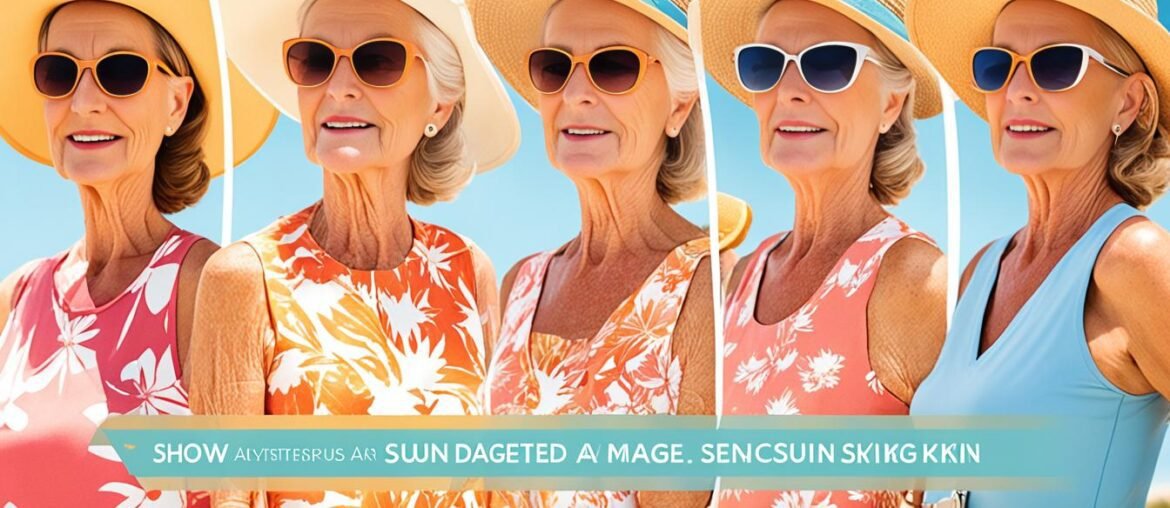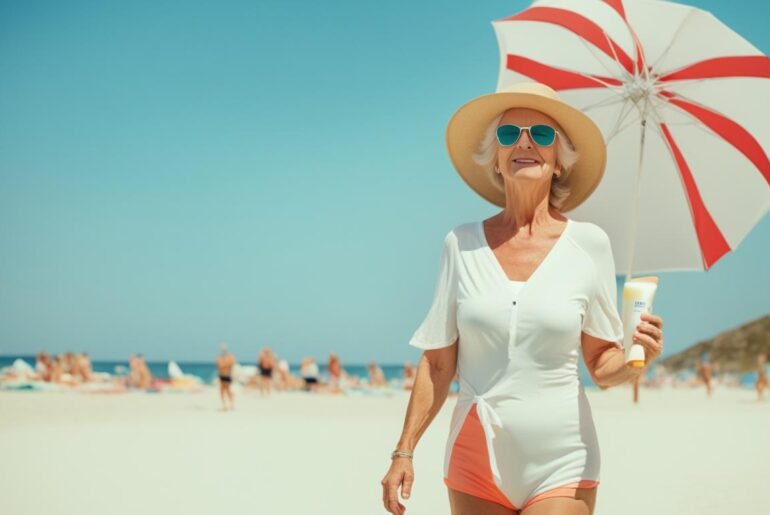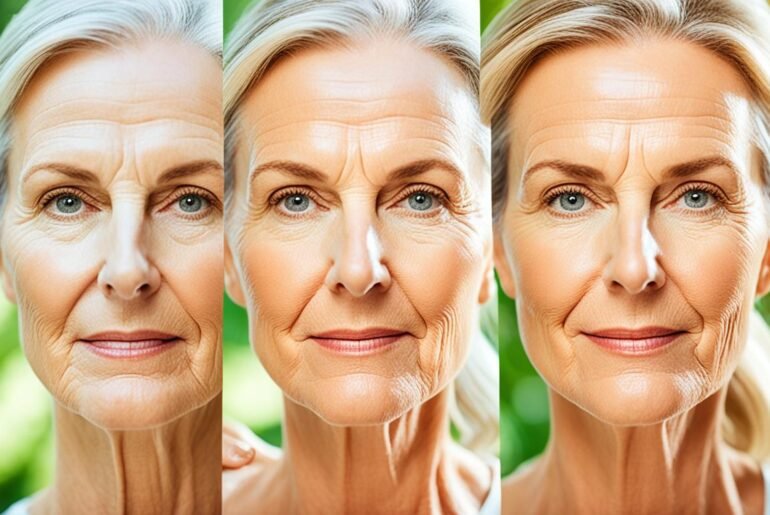Did you know that approximately 90% of visible signs of aging are caused by sun exposure? That’s right, the sun’s harmful rays can significantly accelerate the aging process of your skin, leading to wrinkles, fine lines, age spots, and an increased risk of skin cancer. Protecting your skin from sun damage is essential for maintaining a youthful and healthy complexion. In this article, I will share valuable tips and strategies to help you safeguard your skin from the harmful effects of UV radiation and preserve its youthful appearance. So let’s dive in and discover the secrets to avoiding sun damage on aging skin.
Key Takeaways:
- Approximately 90% of visible signs of aging are caused by sun exposure.
- Sun damage can lead to wrinkles, age spots, and an increased risk of skin cancer.
- Protecting your skin from the sun is crucial for maintaining a youthful complexion.
- In this article, we will share valuable tips and strategies to help you avoid sun damage on aging skin.
What is Photoaging?
Photoaging refers to the detrimental effects on the skin caused by prolonged exposure to UVA and UVB radiation. This type of sun damage can occur not only from natural sunlight but also from artificial sources like tanning beds. UV radiation accelerates the aging process by causing DNA changes in skin cells, leading to premature aging signs such as wrinkles, fine lines, age spots, and a loss of elasticity. Additionally, prolonged exposure to UV radiation increases the risk of developing skin cancer.
To illustrate the impact of UV radiation on the skin, a study conducted by the American Academy of Dermatology found that individuals who regularly used sunscreen with an SPF of 15 or higher showed 24% less skin aging compared to those who did not use sunscreen consistently. These findings emphasize the importance of taking precautions to minimize the effects of photoaging.
By incorporating sun protection strategies and making conscious decisions to avoid excessive sun exposure, individuals can significantly reduce the risk of photoaging and protect their skin against the potential development of skin cancer.
“UV radiation accelerates the aging process, causing DNA changes in skin cells and increasing the risk of skin cancer.”
Who is at Risk for Sun-Damaged Skin?

Everyone is susceptible to sun-damaged skin, but certain factors increase the risk. Individuals with a light skin tone are more vulnerable to the harmful effects of UV radiation. Those with a history of skin cancer or a family history of the disease also face a higher risk of sun damage.
Additional risk factors include having many moles or freckles, and possessing blue or green eyes or light-colored hair. Living or vacationing at high altitudes can intensify UV exposure, as can getting intense weekend sun exposure or spending excessive time outdoors or at tanning salons.
Given these risk factors, it is crucial for individuals to take proactive measures to protect their skin from the damaging effects of the sun’s rays.
Sun Damage in People of Color
While people of color are less likely to get sunburned due to higher levels of melanin, they can still experience sun damage and even sunburns. Sun exposure increases the risk of skin cancer in lighter-skinned individuals, but the relationship between sun exposure and skin cancer in dark-skinned individuals requires further study. Skin cancer in people of color often appears on the palms and soles and is often diagnosed at a later stage.
Strategies for Sun Protection

- Wear broad-spectrum sunscreen with at least SPF 15 to protect against both UVA and UVB rays.
- Seek shade during peak sun hours, typically from 10 am to 4 pm, when the sun’s rays are strongest.
- Wear sun-protective clothing with UPF (Ultraviolet Protection Factor) to cover exposed areas of the skin.
- Put on a wide-brimmed hat to shield your face, neck, and ears from direct sunlight.
- Don’t forget to wear sunglasses that provide UV protection to protect your eyes from harmful rays.
These protective strategies can significantly reduce your risk of sun damage and help maintain the health and appearance of your skin. It’s important to note that sunscreen should be applied generously and reapplied every two hours, especially after swimming or sweating.
Remember, prevention is key when it comes to sun protection, so make these strategies a part of your daily routine. By taking these steps, you can enjoy the outdoors while keeping your skin safe and healthy.
| Strategies | Benefits |
|---|---|
| Wearing broad-spectrum sunscreen | Protects against both UVA and UVB rays |
| Seeking shade during peak sun hours | Reduces direct exposure to harmful rays |
| Using sun-protective clothing | Adds an extra layer of protection for the skin |
| Wearing a wide-brimmed hat | Shields the face, neck, and ears from the sun |
| Using sunglasses with UV protection | Protects the eyes from harmful UV rays |
Skincare Routine for Sun Protection
Incorporating sun protection into your skincare routine is essential. To protect your skin from harmful UV rays and prevent sun damage, follow these steps:
- Cleanse: Start by cleansing your face with a gentle cleanser suitable for your skin type. This helps remove dirt, oil, and impurities, preparing your skin for the rest of the routine.
- Tone: After cleansing, apply a toner to balance your skin’s pH levels and remove any remaining traces of dirt or cleanser. Look for a toner that contains soothing ingredients like chamomile or green tea.
- Treat: Incorporate an anti-aging serum into your routine to target specific concerns caused by sun damage, such as fine lines, wrinkles, and pigmentation. Look for serums with ingredients like retinol, vitamin C, or hyaluronic acid.
- Moisturize: Hydrate your skin with a moisturizer that suits your skin type. Opt for a lightweight formula during the day and a richer formula for nighttime. Look for moisturizers that offer additional sun protection.
- Sunscreen: Apply a broad-spectrum sunscreen with at least SPF 30 as the final step of your skincare routine, both in the morning and before heading outside. Be sure to cover all exposed skin areas, including your face, neck, and any other areas that will be exposed to the sun.
Remember to reapply sunscreen every two hours, especially if you are sweating or swimming. Additionally, consider incorporating other forms of sun protection such as wearing a wide-brimmed hat, sunglasses, and sun-protective clothing to further safeguard your skin from harmful UV rays.
“Protecting your skin from the sun should be an integral part of your daily skincare routine. Sunscreen is your best defense against premature aging and skin damage caused by UV radiation.”
In addition to sun protection, it’s important to use skincare products that contain antioxidants and ingredients proven to combat the signs of aging caused by sun damage, such as retinoids, vitamin C, and hyaluronic acid. These ingredients help promote collagen production, fade dark spots, and improve overall skin texture.
By following a consistent skincare routine that includes sun protection and anti-aging skincare products, you can maintain healthy, glowing skin and reduce the visible signs of sun damage.
Importance of Regular Skin Checkups
Regular skin checkups with a dermatologist are a crucial part of maintaining skin health. These checkups enable early detection and monitoring of any potential skin abnormalities or signs of skin cancer. By scheduling regular appointments with a dermatologist, you can ensure that your skin is thoroughly evaluated and any concerning areas are addressed promptly.
During a skin checkup, a dermatologist will perform a comprehensive examination of your skin, including areas that may be difficult for you to see or reach. They will assess moles, lesions, and any other skin irregularities, looking for signs of skin cancer or other dermatological conditions.
Benefits of Regular Skin Checkups
There are several benefits to regular skin checkups:
- Early Detection: Regular appointments increase the chances of detecting skin cancer or other skin conditions at an early stage. Early detection significantly improves prognosis and treatment outcomes.
- Expert Evaluation: Dermatologists are trained specialists who can identify subtle changes or abnormalities in the skin that may go unnoticed by an untrained eye.
- Peace of Mind: Regular checkups provide reassurance and peace of mind, knowing that your skin health is being monitored by a professional.
- Personalized Recommendations: A dermatologist can offer personalized recommendations for sun protection, skincare routines, and overall skin health based on your specific needs and concerns.
- Education and Awareness: Skin checkups offer an opportunity to learn more about your skin, understand potential risks, and receive guidance on maintaining healthy skin.
When to Schedule a Skin Checkup
It is recommended to undergo a full-body skin check with a dermatologist annually. However, certain individuals may require more frequent checkups, especially if they have a personal or family history of skin cancer, multiple moles, or other risk factors. Consult with your dermatologist to determine the optimal frequency of skin checkups based on your individual circumstances.
Lifestyle Choices for Sun Damage Prevention

When it comes to preventing sun damage, making conscious lifestyle choices is key. By taking simple precautions and adopting sun-safe habits, you can protect your skin from harmful UV radiation and minimize the risk of sun damage. Here are some effective strategies:
Avoiding Peak Sun Hours
One of the most important lifestyle choices for sun damage prevention is to avoid outdoor activities during peak sun hours. The sun’s rays are strongest between 10 a.m. and 4 p.m., so limiting your time outdoors during this period can significantly reduce your exposure to harmful UV radiation.
Seeking Shade
Seeking shade whenever possible is another effective way to protect your skin from sun damage. When you’re outdoors, look for shelters like trees, umbrellas, or covered areas to minimize direct sun exposure. This can provide an extra layer of protection and help reduce the harmful effects of UV radiation.
Wearing Protective Clothing and Accessories
Investing in sun-protective clothing and accessories is essential for safeguarding your skin. Opt for lightweight, long-sleeved shirts, pants, and skirts that cover your arms and legs. Additionally, wear wide-brimmed hats to shield your face, neck, and ears from direct sunlight. Don’t forget to put on sunglasses that provide UV protection to shield your eyes from the sun’s harmful rays.
Limiting Tanning Bed and UV Light Exposure
It’s crucial to limit your exposure to tanning beds and artificial sources of UV light. Tanning beds emit high amounts of UVA and UVB radiation, which can accelerate skin aging and increase the risk of skin cancer. If you desire a bronzed look, consider using self-tanning products as a safer alternative.
By adopting these lifestyle choices, you can significantly reduce the risk of sun damage and promote healthier, younger-looking skin. Remember, prevention is key when it comes to protecting yourself from the damaging effects of the sun.
Conclusion
As I conclude this article, I want to emphasize the importance of protecting your skin from sun damage to maintain a radiant and youthful complexion. By implementing effective sun protection strategies and incorporating sunscreen into your daily skincare routine, you can minimize the visible effects of photoaging and reduce the risk of skin cancer.
Remember to prioritize sun safety in your lifestyle choices by avoiding peak sun hours, seeking shade whenever possible, and wearing protective clothing and accessories. These simple yet impactful steps can go a long way in preserving the health and appearance of your skin.
Furthermore, I highly recommend consulting with a dermatologist for regular skin checkups and personalized recommendations. A professional can assess your skin’s specific needs and provide guidance on selecting the right anti-aging skincare products and treatments that suit your individual concerns.
By following these tips and incorporating sun protection into your daily routine, you can achieve healthier, more youthful-looking skin and maintain its vitality for years to come.
FAQ
What is photoaging?
Photoaging is the premature aging of the skin caused by exposure to ultraviolet A (UVA) and ultraviolet B (UVB) radiation. It can lead to wrinkles, discoloration, and an increased risk of skin cancer.
Who is at risk for sun-damaged skin?
People with light skin tones, a history of skin cancer or a family history of skin cancer, many moles, freckles, and those with blue or green eyes or light-colored hair are at higher risk. Living or vacationing at high altitudes, getting intense weekend sun exposure, and spending a lot of time outdoors or at tanning salons also increase the risk.
Can people of color experience sun damage?
While people of color are less likely to get sunburned due to higher levels of melanin, they can still experience sun damage and even sunburns. Sun exposure increases the risk of skin cancer in lighter-skinned individuals, but the relationship between sun exposure and skin cancer in dark-skinned individuals requires further study.
What are some strategies for sun protection?
Some strategies include wearing broad-spectrum sunscreen with at least SPF 15, seeking shade during peak sun hours, wearing protective clothing with UPF, and wearing a wide-brimmed hat and sunglasses. Sunscreen should be reapplied every two hours and more frequently if swimming or sweating.
What should be included in a skincare routine for sun protection?
Incorporating sun protection into your skincare routine is essential. Apply a broad-spectrum sunscreen with at least SPF 30 every morning as the last step of your skincare routine. Reapply sunscreen every two hours and use additional forms of protection such as hats, sunglasses, and sun-protective clothing. Use skincare products that contain antioxidants and ingredients like retinoids, vitamin C, and hyaluronic acid to combat the signs of aging caused by sun damage.
Why are regular skin checkups important?
Regular skin checkups with a dermatologist are crucial for early detection of any potential skin abnormalities or signs of skin cancer. A dermatologist can evaluate your skin, perform a full-body examination, and provide recommendations for sun protection and maintaining healthy skin. Early detection and treatment greatly increase the chances of successful outcomes.
What lifestyle choices can help prevent sun damage?
Making lifestyle choices that prioritize sun safety is essential for preventing sun damage. Avoid outdoor activities during peak sun hours, seek shade whenever possible, and wear protective clothing and accessories. Limit exposure to tanning beds and artificial UV light sources.




